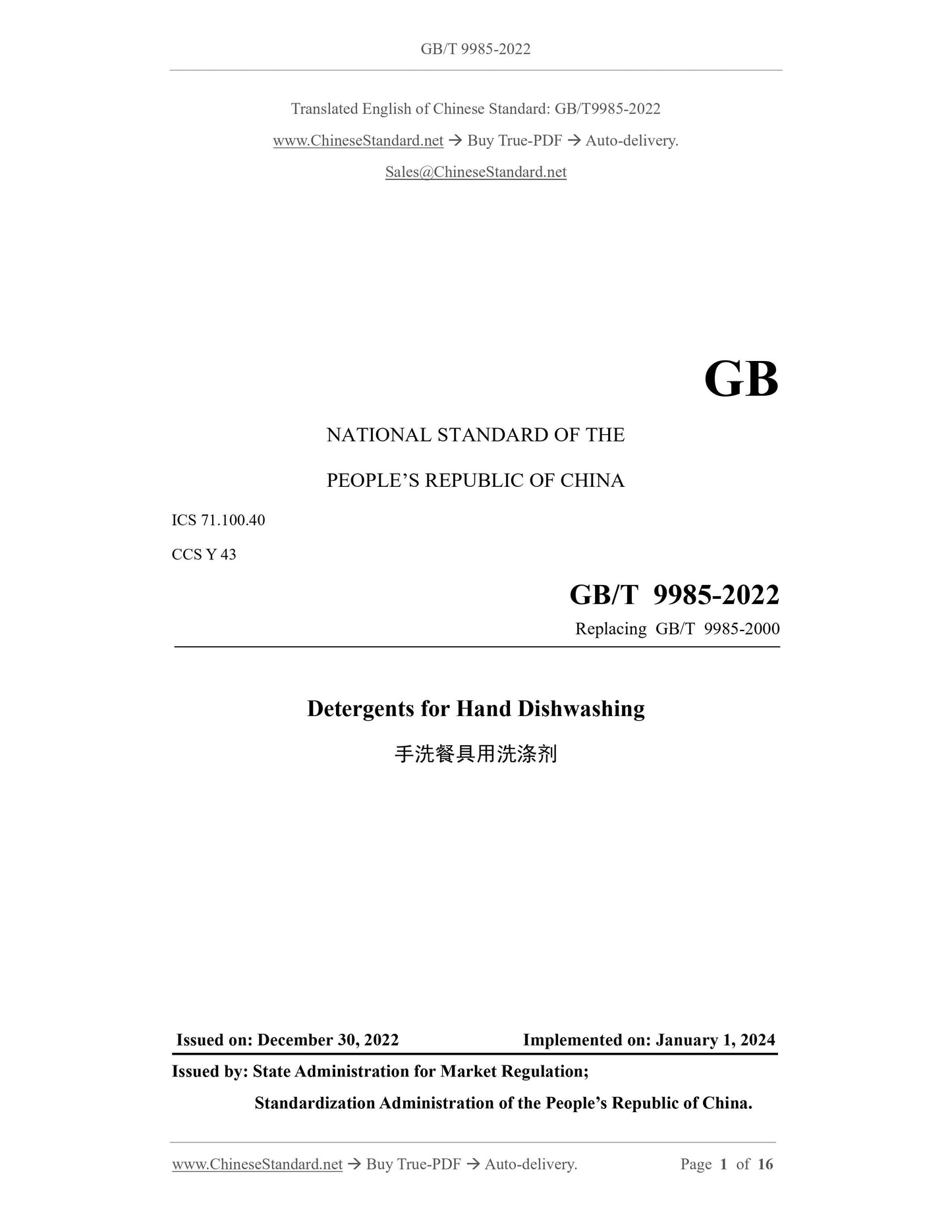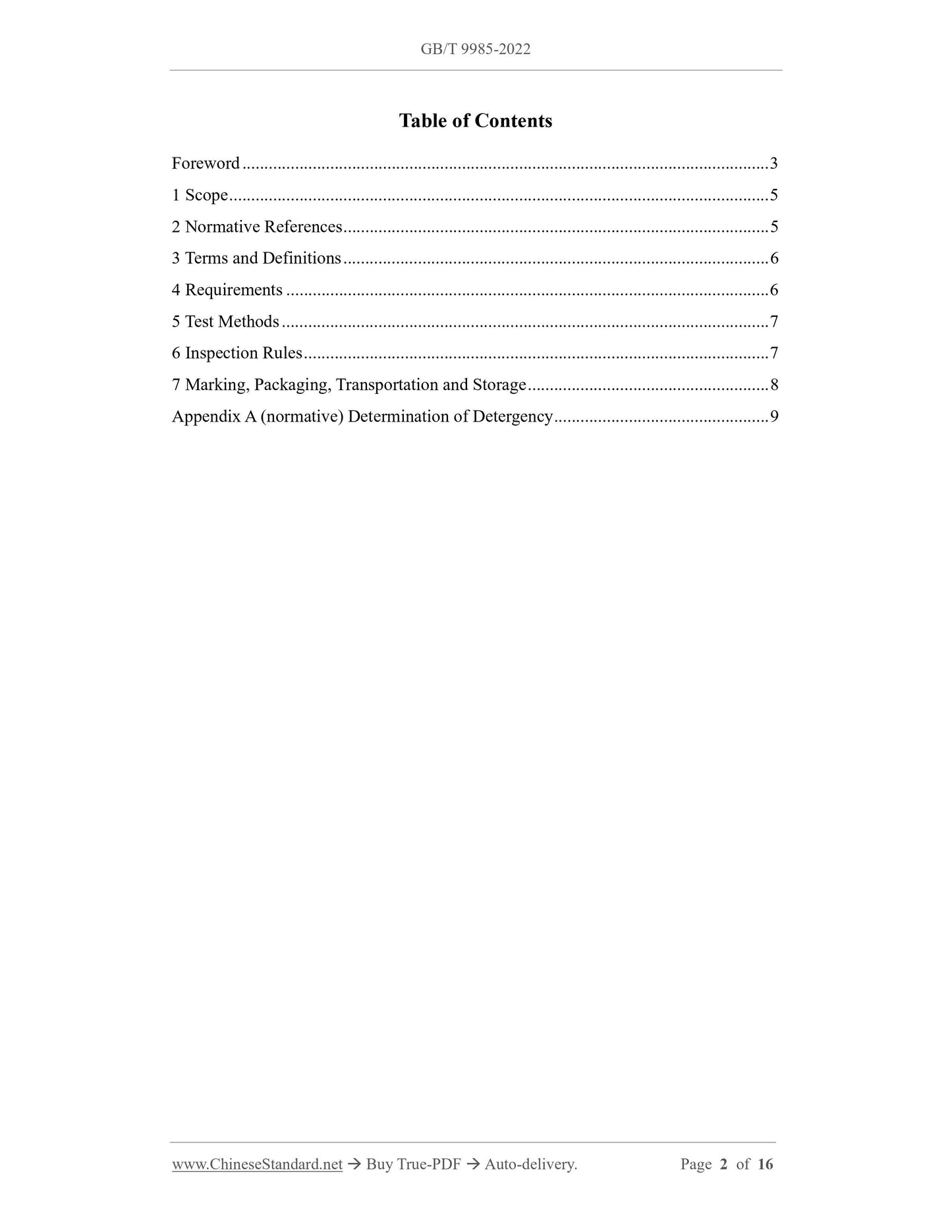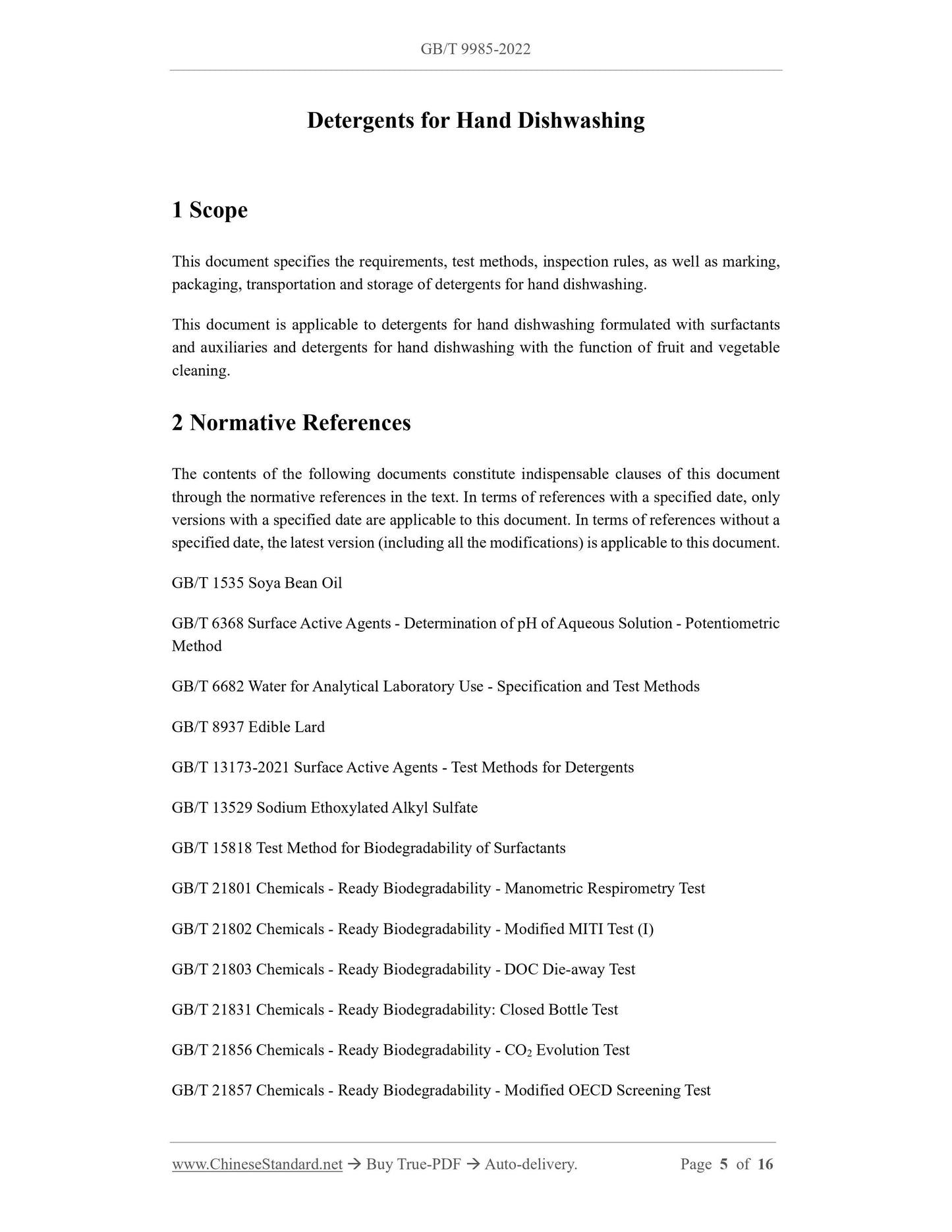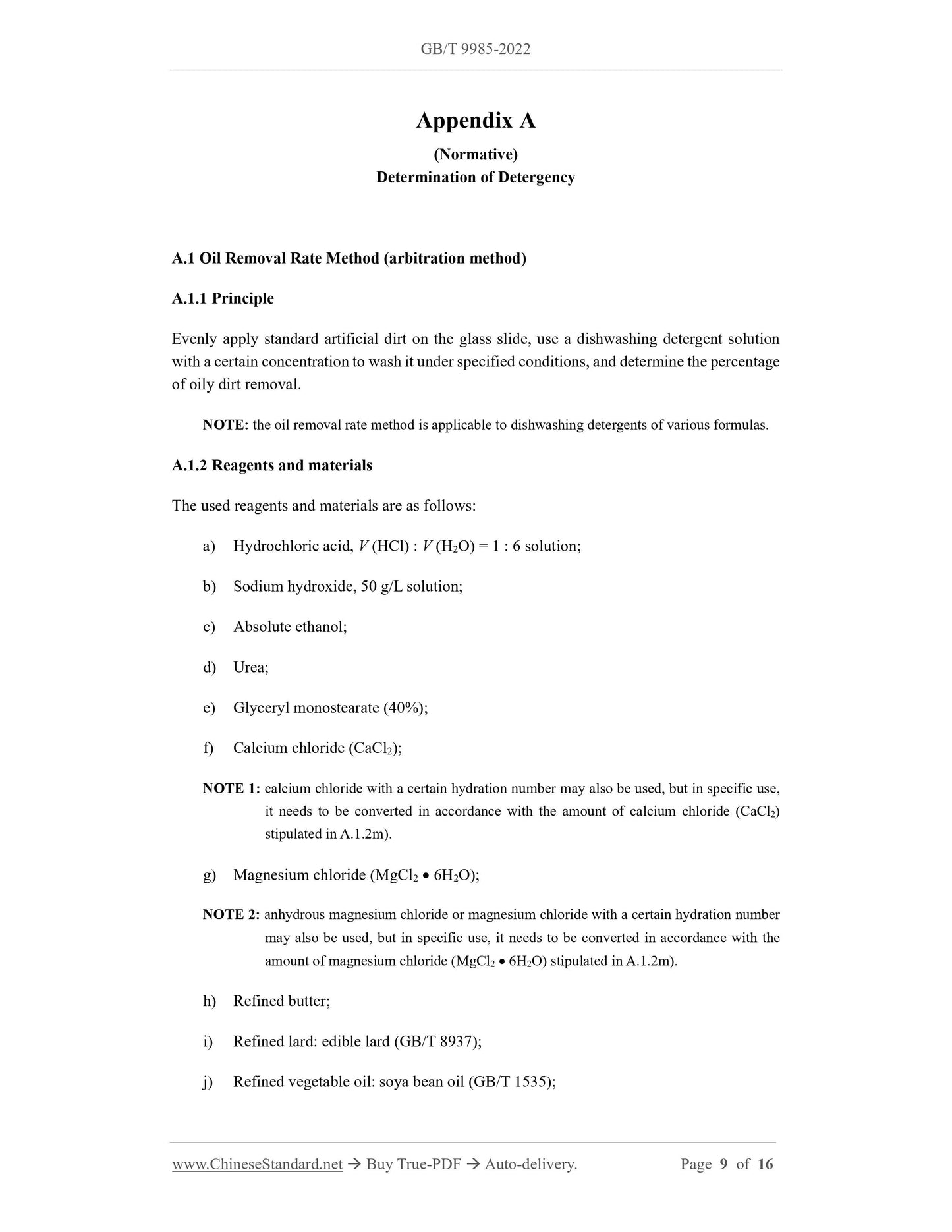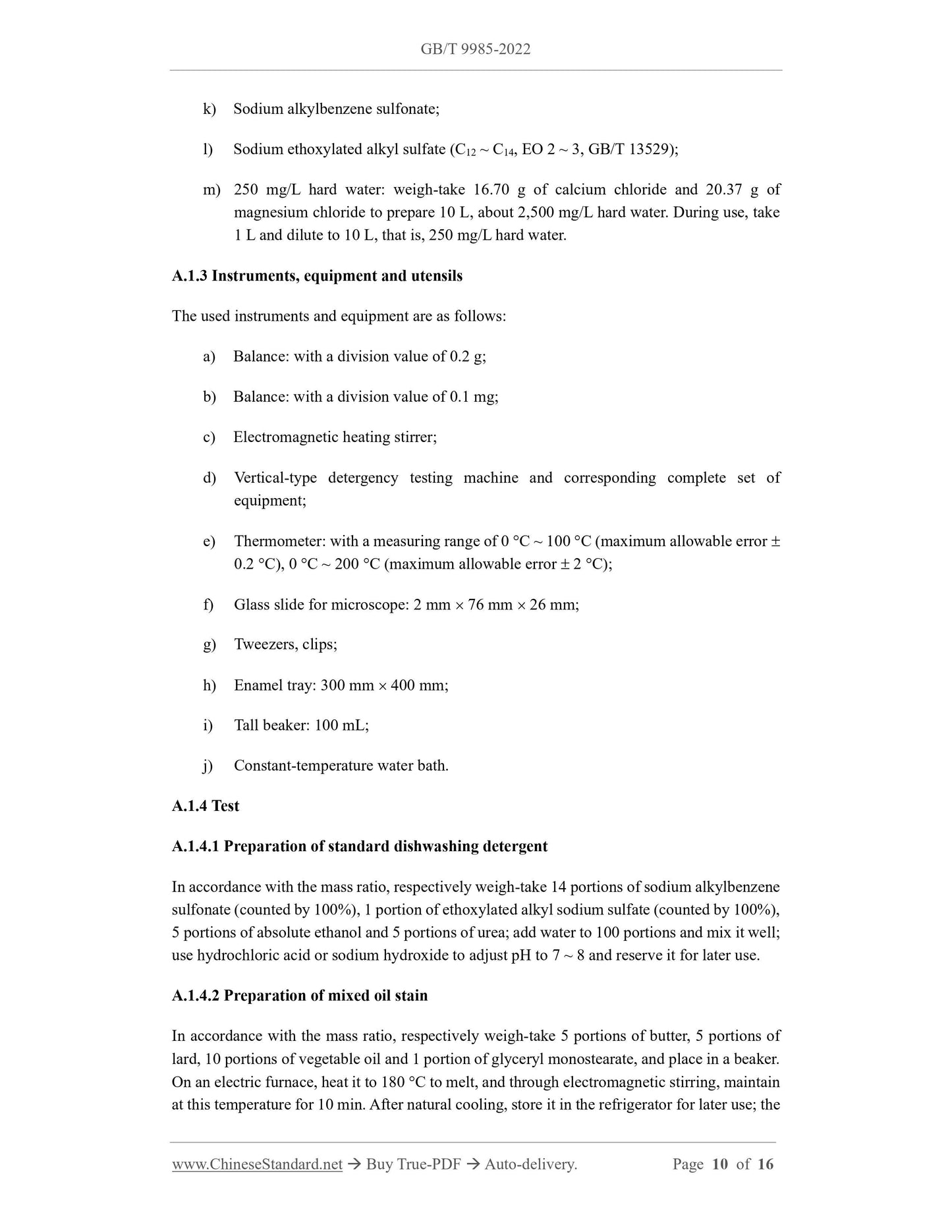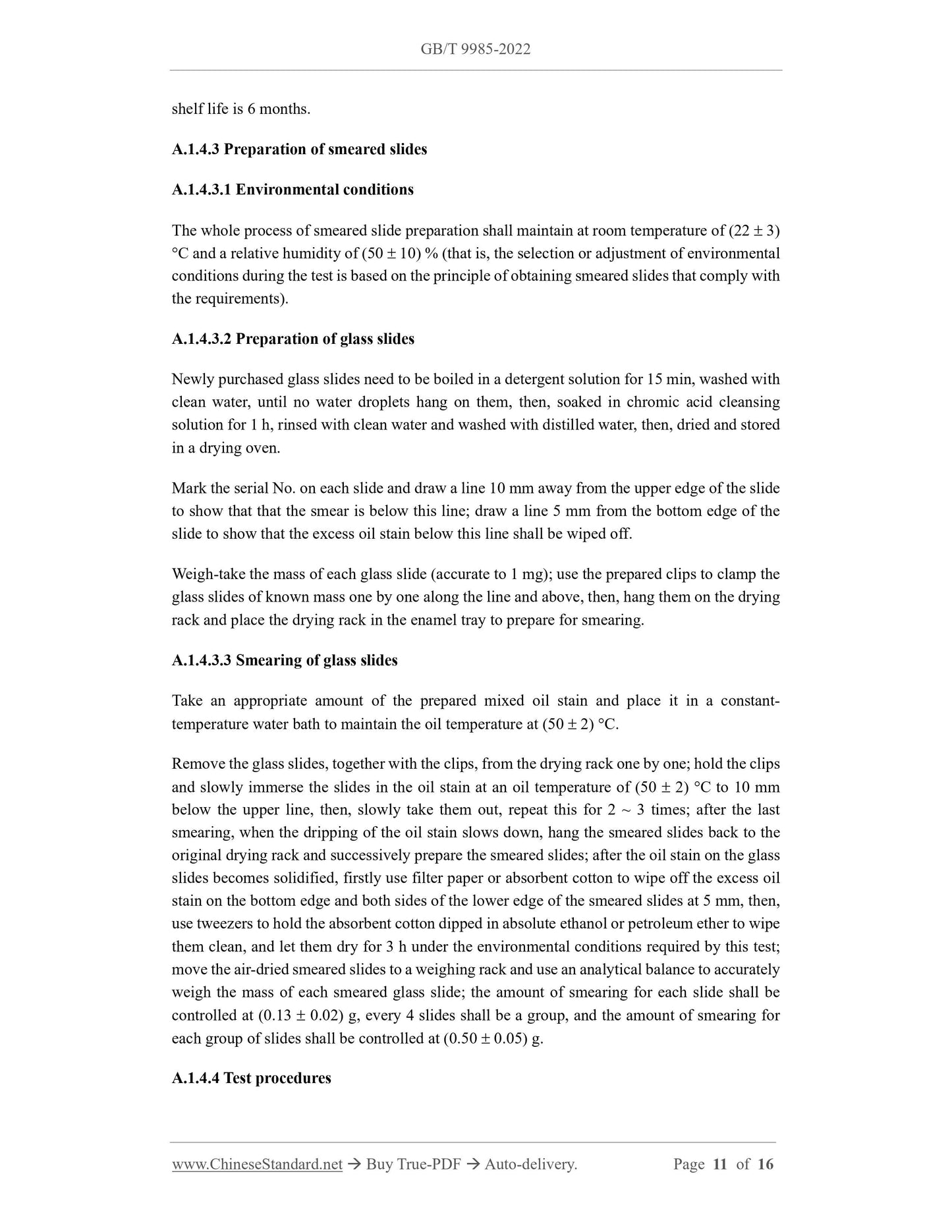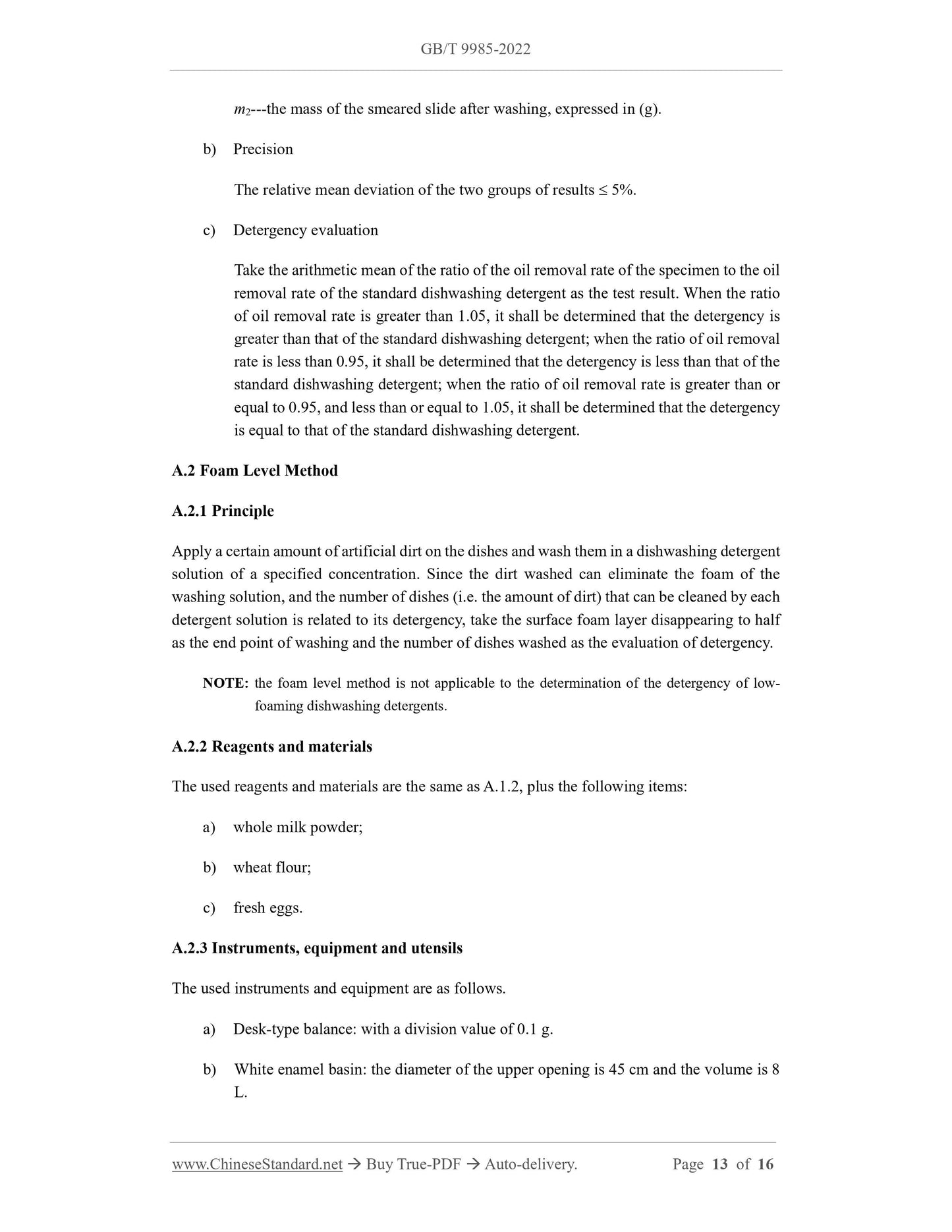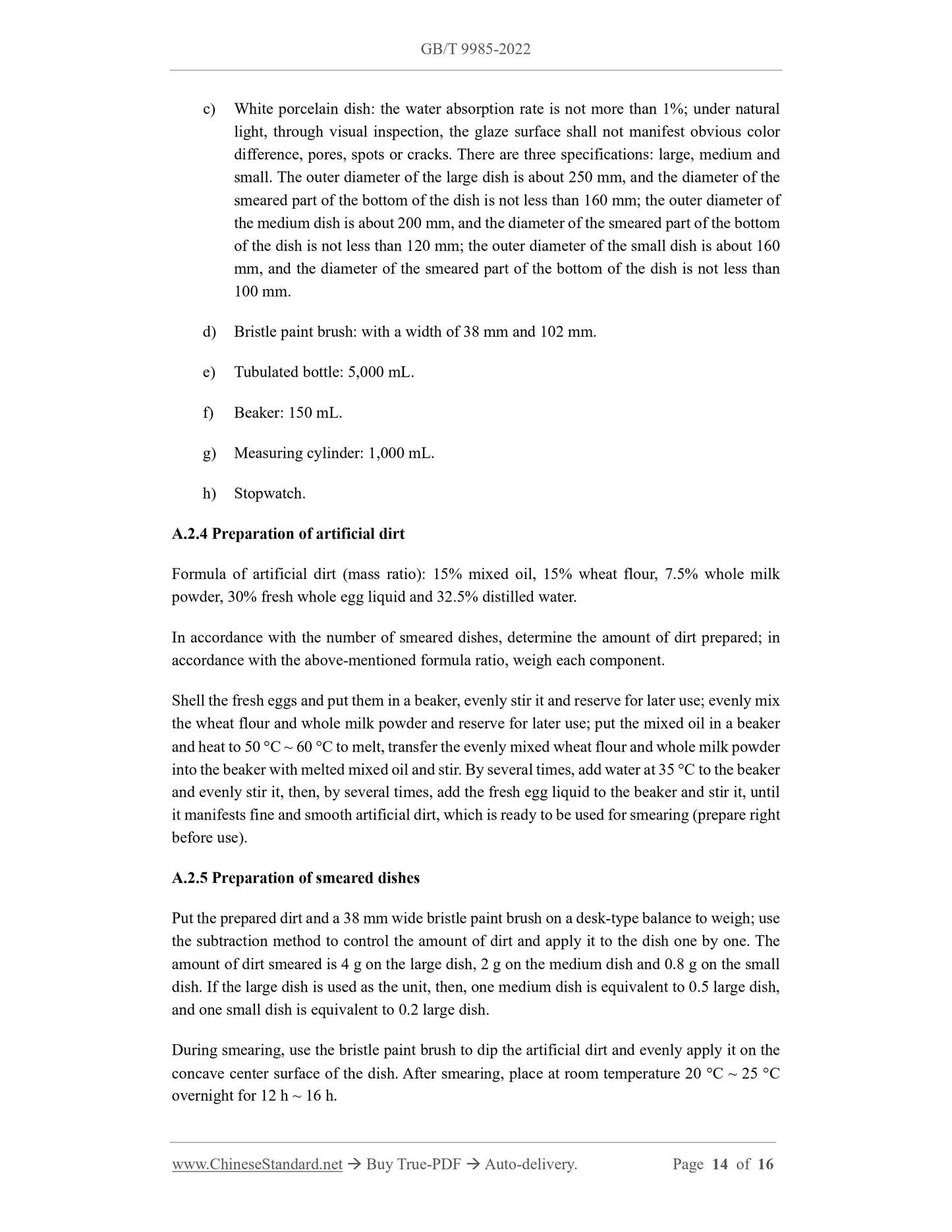1
/
of
8
PayPal, credit cards. Download editable-PDF and invoice in 1 second!
GB/T 9985-2022 English PDF (GBT9985-2022)
GB/T 9985-2022 English PDF (GBT9985-2022)
Regular price
$170.00 USD
Regular price
Sale price
$170.00 USD
Unit price
/
per
Shipping calculated at checkout.
Couldn't load pickup availability
Delivery: 3 seconds. Download true-PDF + Invoice.
Get QUOTATION in 1-minute: Click GB/T 9985-2022
Historical versions: GB/T 9985-2022
Preview True-PDF (Reload/Scroll if blank)
GB/T 9985-2022: Detergents for hand dishwashing
GB/T 9985-2022
GB
NATIONAL STANDARD OF THE
PEOPLE’S REPUBLIC OF CHINA
ICS 71.100.40
CCS Y 43
Replacing GB/T 9985-2000
Detergents for Hand Dishwashing
ISSUED ON: DECEMBER 30, 2022
IMPLEMENTED ON: JANUARY 1, 2024
Issued by: State Administration for Market Regulation;
Standardization Administration of the People’s Republic of China.
Table of Contents
Foreword ... 3
1 Scope ... 5
2 Normative References ... 5
3 Terms and Definitions ... 6
4 Requirements ... 6
5 Test Methods ... 7
6 Inspection Rules ... 7
7 Marking, Packaging, Transportation and Storage ... 8
Appendix A (normative) Determination of Detergency ... 9
Detergents for Hand Dishwashing
1 Scope
This document specifies the requirements, test methods, inspection rules, as well as marking,
packaging, transportation and storage of detergents for hand dishwashing.
This document is applicable to detergents for hand dishwashing formulated with surfactants
and auxiliaries and detergents for hand dishwashing with the function of fruit and vegetable
cleaning.
2 Normative References
The contents of the following documents constitute indispensable clauses of this document
through the normative references in the text. In terms of references with a specified date, only
versions with a specified date are applicable to this document. In terms of references without a
specified date, the latest version (including all the modifications) is applicable to this document.
GB/T 1535 Soya Bean Oil
GB/T 6368 Surface Active Agents - Determination of pH of Aqueous Solution - Potentiometric
Method
GB/T 6682 Water for Analytical Laboratory Use - Specification and Test Methods
GB/T 8937 Edible Lard
GB/T 13173-2021 Surface Active Agents - Test Methods for Detergents
GB/T 13529 Sodium Ethoxylated Alkyl Sulfate
GB/T 15818 Test Method for Biodegradability of Surfactants
GB/T 21801 Chemicals - Ready Biodegradability - Manometric Respirometry Test
GB/T 21802 Chemicals - Ready Biodegradability - Modified MITI Test (I)
GB/T 21803 Chemicals - Ready Biodegradability - DOC Die-away Test
GB/T 21831 Chemicals - Ready Biodegradability: Closed Bottle Test
GB/T 21856 Chemicals - Ready Biodegradability - CO2 Evolution Test
GB/T 21857 Chemicals - Ready Biodegradability - Modified OECD Screening Test
Appendix A
(Normative)
Determination of Detergency
A.1 Oil Removal Rate Method (arbitration method)
A.1.1 Principle
Evenly apply standard artificial dirt on the glass slide, use a dishwashing detergent solution
with a certain concentration to wash it under specified conditions, and determine the percentage
of oily dirt removal.
NOTE: the oil removal rate method is applicable to dishwashing detergents of various formulas.
A.1.2 Reagents and materials
The used reagents and materials are as follows:
a) Hydrochloric acid, V (HCl) : V (H2O) = 1 : 6 solution;
b) Sodium hydroxide, 50 g/L solution;
c) Absolute ethanol;
d) Urea;
e) Glyceryl monostearate (40%);
f) Calcium chloride (CaCl2);
NOTE 1: calcium chloride with a certain hydration number may also be used, but in specific use,
it needs to be converted in accordance with the amount of calcium chloride (CaCl2)
stipulated in A.1.2m).
g) Magnesium chloride (MgCl2 6H2O);
NOTE 2: anhydrous magnesium chloride or magnesium chloride with a certain hydration number
may also be used, but in specific use, it needs to be converted in accordance with the
amount of magnesium chloride (MgCl2 6H2O) stipulated in A.1.2m).
h) Refined butter;
i) Refined lard: edible lard (GB/T 8937);
j) Refined vegetable oil: soya bean oil (GB/T 1535);
k) Sodium alkylbenzene sulfonate;
l) Sodium ethoxylated alkyl sulfate (C12 ~ C14, EO 2 ~ 3, GB/T 13529);
m) 250 mg/L hard water: weigh-take 16.70 g of calcium chloride and 20.37 g of
magnesium chloride to prepare 10 L, about 2,500 mg/L hard water. During use, take
1 L and dilute to 10 L, that is, 250 mg/L hard water.
A.1.3 Instruments, equipment and utensils
The used instruments and equipment are as follows:
a) Balance: with a division value of 0.2 g;
b) Balance: with a division value of 0.1 mg;
c) Electromagnetic heating stirrer;
d) Vertical-type detergency testing machine and corresponding complete set of
equipment;
e) Thermometer: with a measuring range of 0 C ~ 100 C (maximum allowable error
0.2 C), 0 C ~ 200 C (maximum allowable error 2 C);
f) Glass slide for microscope: 2 mm 76 mm 26 mm;
g) Tweezers, clips;
h) Enamel tray: 300 mm 400 mm;
i) Tall beaker: 100 mL;
j) Constant-temperature water bath.
A.1.4 Test
A.1.4.1 Preparation of standard dishwashing detergent
In accordance with the mass ratio, respectively weigh-take 14 portions of sodium alkylbenzene
sulfonate (counted by 100%), 1 portion of ethoxylated alkyl sodium sulfate (counted by 100%),
5 portions of absolute ethanol and 5 portions of urea; add water to 100 portions and mix it well;
use hydrochloric acid or sodium hydroxide to adjust pH to 7 ~ 8 and reserve it for later use.
A.1.4.2 Preparation of mixed oil stain
In accordance with the mass ratio, respectively weigh-take 5 portions of butter, 5 portions of
lard, 10 portions of vegetable oil and 1 portion of glyceryl monostearate, and place in a beaker.
On an electric furnace, heat it to 180 C to melt, and through electromagnetic stirring, maintain
at this temperature for 10 min. After natural cooling, store it in the refrigerator for later use; the
shelf life is 6 months.
A.1.4.3 Preparation of smeared slides
A.1.4.3.1 Environmental conditions
The whole process of smeared slide preparation shall maintain at room temperature of (22 3)
C and a relative humidity of (50 10) % (that is, the selection or adjustment of environmental
conditions during the test is based on the principle of obtaining smeared slides that comply with
the requirements).
A.1.4.3.2 Preparation of glass slides
Newly purchased glass slides need to be boiled in a detergent solution for 15 min, washed with
clean water, until no water droplets hang on them, then, soaked in chromic acid cleansing
solution for 1 h, rinsed with clean water and washed with distilled water, then, dried and stored
in a drying oven.
Mark the serial No. on each slide and draw a line 10 mm away from the upper edge of the slide
to show that that the smear is below this line; draw a line 5 mm from the bottom edge of the
slide to show that the excess oil stain below this line shall be wiped off.
Weigh-take the mass of each glass slide (accurate to 1 mg); use the prepared clips to clamp the
glass slides of known mass one by one along the line and above, then, hang them on the drying
rack and place the drying rack in the enamel tray to prepare for smearing.
A.1.4.3.3 Smearing of glass slides
Take an appropriate amount of the prepared mixed oil stain and place it in a constant-
temperature water bath to maintain the oil temperature at (50 2) C.
Remove the glass slides, together with the clips, from the drying rack one by one; hold the clips
and slowly immerse the slides in the oil stain at an oil temperature of (50 2) C to 10 mm
below the upper line, then, slowly take them out, repeat this for 2 ~ 3 times; after the last
smearing, when the dripping of the oil stain slows down, hang the smeared slides back to the
original drying rack and successively prepare the smeared slides; after the oil stain on the glass
slides becomes solidified, firstly use filter paper or absor...
Get QUOTATION in 1-minute: Click GB/T 9985-2022
Historical versions: GB/T 9985-2022
Preview True-PDF (Reload/Scroll if blank)
GB/T 9985-2022: Detergents for hand dishwashing
GB/T 9985-2022
GB
NATIONAL STANDARD OF THE
PEOPLE’S REPUBLIC OF CHINA
ICS 71.100.40
CCS Y 43
Replacing GB/T 9985-2000
Detergents for Hand Dishwashing
ISSUED ON: DECEMBER 30, 2022
IMPLEMENTED ON: JANUARY 1, 2024
Issued by: State Administration for Market Regulation;
Standardization Administration of the People’s Republic of China.
Table of Contents
Foreword ... 3
1 Scope ... 5
2 Normative References ... 5
3 Terms and Definitions ... 6
4 Requirements ... 6
5 Test Methods ... 7
6 Inspection Rules ... 7
7 Marking, Packaging, Transportation and Storage ... 8
Appendix A (normative) Determination of Detergency ... 9
Detergents for Hand Dishwashing
1 Scope
This document specifies the requirements, test methods, inspection rules, as well as marking,
packaging, transportation and storage of detergents for hand dishwashing.
This document is applicable to detergents for hand dishwashing formulated with surfactants
and auxiliaries and detergents for hand dishwashing with the function of fruit and vegetable
cleaning.
2 Normative References
The contents of the following documents constitute indispensable clauses of this document
through the normative references in the text. In terms of references with a specified date, only
versions with a specified date are applicable to this document. In terms of references without a
specified date, the latest version (including all the modifications) is applicable to this document.
GB/T 1535 Soya Bean Oil
GB/T 6368 Surface Active Agents - Determination of pH of Aqueous Solution - Potentiometric
Method
GB/T 6682 Water for Analytical Laboratory Use - Specification and Test Methods
GB/T 8937 Edible Lard
GB/T 13173-2021 Surface Active Agents - Test Methods for Detergents
GB/T 13529 Sodium Ethoxylated Alkyl Sulfate
GB/T 15818 Test Method for Biodegradability of Surfactants
GB/T 21801 Chemicals - Ready Biodegradability - Manometric Respirometry Test
GB/T 21802 Chemicals - Ready Biodegradability - Modified MITI Test (I)
GB/T 21803 Chemicals - Ready Biodegradability - DOC Die-away Test
GB/T 21831 Chemicals - Ready Biodegradability: Closed Bottle Test
GB/T 21856 Chemicals - Ready Biodegradability - CO2 Evolution Test
GB/T 21857 Chemicals - Ready Biodegradability - Modified OECD Screening Test
Appendix A
(Normative)
Determination of Detergency
A.1 Oil Removal Rate Method (arbitration method)
A.1.1 Principle
Evenly apply standard artificial dirt on the glass slide, use a dishwashing detergent solution
with a certain concentration to wash it under specified conditions, and determine the percentage
of oily dirt removal.
NOTE: the oil removal rate method is applicable to dishwashing detergents of various formulas.
A.1.2 Reagents and materials
The used reagents and materials are as follows:
a) Hydrochloric acid, V (HCl) : V (H2O) = 1 : 6 solution;
b) Sodium hydroxide, 50 g/L solution;
c) Absolute ethanol;
d) Urea;
e) Glyceryl monostearate (40%);
f) Calcium chloride (CaCl2);
NOTE 1: calcium chloride with a certain hydration number may also be used, but in specific use,
it needs to be converted in accordance with the amount of calcium chloride (CaCl2)
stipulated in A.1.2m).
g) Magnesium chloride (MgCl2 6H2O);
NOTE 2: anhydrous magnesium chloride or magnesium chloride with a certain hydration number
may also be used, but in specific use, it needs to be converted in accordance with the
amount of magnesium chloride (MgCl2 6H2O) stipulated in A.1.2m).
h) Refined butter;
i) Refined lard: edible lard (GB/T 8937);
j) Refined vegetable oil: soya bean oil (GB/T 1535);
k) Sodium alkylbenzene sulfonate;
l) Sodium ethoxylated alkyl sulfate (C12 ~ C14, EO 2 ~ 3, GB/T 13529);
m) 250 mg/L hard water: weigh-take 16.70 g of calcium chloride and 20.37 g of
magnesium chloride to prepare 10 L, about 2,500 mg/L hard water. During use, take
1 L and dilute to 10 L, that is, 250 mg/L hard water.
A.1.3 Instruments, equipment and utensils
The used instruments and equipment are as follows:
a) Balance: with a division value of 0.2 g;
b) Balance: with a division value of 0.1 mg;
c) Electromagnetic heating stirrer;
d) Vertical-type detergency testing machine and corresponding complete set of
equipment;
e) Thermometer: with a measuring range of 0 C ~ 100 C (maximum allowable error
0.2 C), 0 C ~ 200 C (maximum allowable error 2 C);
f) Glass slide for microscope: 2 mm 76 mm 26 mm;
g) Tweezers, clips;
h) Enamel tray: 300 mm 400 mm;
i) Tall beaker: 100 mL;
j) Constant-temperature water bath.
A.1.4 Test
A.1.4.1 Preparation of standard dishwashing detergent
In accordance with the mass ratio, respectively weigh-take 14 portions of sodium alkylbenzene
sulfonate (counted by 100%), 1 portion of ethoxylated alkyl sodium sulfate (counted by 100%),
5 portions of absolute ethanol and 5 portions of urea; add water to 100 portions and mix it well;
use hydrochloric acid or sodium hydroxide to adjust pH to 7 ~ 8 and reserve it for later use.
A.1.4.2 Preparation of mixed oil stain
In accordance with the mass ratio, respectively weigh-take 5 portions of butter, 5 portions of
lard, 10 portions of vegetable oil and 1 portion of glyceryl monostearate, and place in a beaker.
On an electric furnace, heat it to 180 C to melt, and through electromagnetic stirring, maintain
at this temperature for 10 min. After natural cooling, store it in the refrigerator for later use; the
shelf life is 6 months.
A.1.4.3 Preparation of smeared slides
A.1.4.3.1 Environmental conditions
The whole process of smeared slide preparation shall maintain at room temperature of (22 3)
C and a relative humidity of (50 10) % (that is, the selection or adjustment of environmental
conditions during the test is based on the principle of obtaining smeared slides that comply with
the requirements).
A.1.4.3.2 Preparation of glass slides
Newly purchased glass slides need to be boiled in a detergent solution for 15 min, washed with
clean water, until no water droplets hang on them, then, soaked in chromic acid cleansing
solution for 1 h, rinsed with clean water and washed with distilled water, then, dried and stored
in a drying oven.
Mark the serial No. on each slide and draw a line 10 mm away from the upper edge of the slide
to show that that the smear is below this line; draw a line 5 mm from the bottom edge of the
slide to show that the excess oil stain below this line shall be wiped off.
Weigh-take the mass of each glass slide (accurate to 1 mg); use the prepared clips to clamp the
glass slides of known mass one by one along the line and above, then, hang them on the drying
rack and place the drying rack in the enamel tray to prepare for smearing.
A.1.4.3.3 Smearing of glass slides
Take an appropriate amount of the prepared mixed oil stain and place it in a constant-
temperature water bath to maintain the oil temperature at (50 2) C.
Remove the glass slides, together with the clips, from the drying rack one by one; hold the clips
and slowly immerse the slides in the oil stain at an oil temperature of (50 2) C to 10 mm
below the upper line, then, slowly take them out, repeat this for 2 ~ 3 times; after the last
smearing, when the dripping of the oil stain slows down, hang the smeared slides back to the
original drying rack and successively prepare the smeared slides; after the oil stain on the glass
slides becomes solidified, firstly use filter paper or absor...
Share
